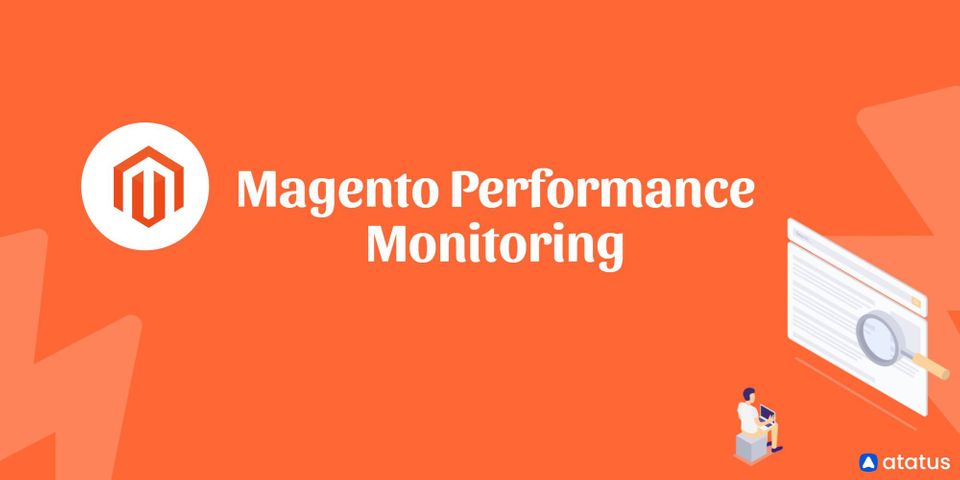Monitoring Magento (now Abode Commerce): Simple Metrics for Effective Management
Magento is a popular open-source e-commerce platform that offers merchants a flexible and powerful solution for their online stores. It's known for its scalability, extensive features, and ability to customize, making it a choice for businesses of all sizes.
Magento was launched in 2008 by a company called Varien. It quickly rose to prominence as one of the leading e-commerce solutions. It came in two primary editions previously
- Magento Open Source, which is the free version of Magento, suitable for smaller businesses that need standard e-commerce features.
- Magento Commerce is a premium version with additional features, cloud hosting solutions, and support. It's designed for medium to large businesses requiring a more comprehensive solution.
In 2018, Adobe acquired Magento, bringing it into its suite of tools and further emphasizing the platform's place in the e-commerce industry. Magento 2 is now available as version 1 was revamped in 2020. The migration has brought a whole new architecture, making it significantly better performant with improved features.
Magento is a powerful platform for building and managing online stores, but it does require some technical expertise to set up and maintain. Many businesses work with Magento developers or agencies to ensure their online stores are optimized for performance, security, and user experience.
We will see what metrics to look at to keep your Magento up-to-date. Learn more on Magento Performance Monitoring here!
Table Of Contents:-
1. Website Traffic
Website traffic refers to the engagement happening on your website for a fixed period of time. It is based on the number of times users have visited your site, how many pages each one of them has viewed, the number of these visitors who are new to your site, and also the number of people who log out after going through just a single page - which is called as bounce rate.
Ideally, a business should have more daily visitors who spend more time on your website than a high bounce rate.
- Page load times
- Server response time
- Traffic sources (organic, paid, referral)
- Bounce rate
- Unique visitors
2. Website Performance
Website performance takes into account all the activities linked to your page. For example, page load time measures the wait time associated with each load click. Server uptime measures the amount of time your server is completely operational and works smoothly.
Error rates measure the frequency of any error message on your website screen, be it in the product catalog or even during accessing your profile, cart, or browsing history.
- Page load time for key pages (home, product, checkout)
- Server response time
- Website uptime and downtime
- Mobile vs. desktop performance
3. Product Metrics
You will have an array of different products in your store. There will always be some niche categories that always show high sales, for example, electronic items are mostly bought online over clothes or groceries.
So, these items will have a high click-through rate. The ratio of clicks to product page impressions. Also, product metrics include product views and the best-selling products.
- Website page load times
- Product availability (in stock/out of stock)
- Product reviews and ratings
- Click-through rates on product listings
4. Sales Metrics
This metric measures the total sales happening from your site. It includes total sales, conversion rate (the number of visitors who make a purchase), average order value, and the revenue generated per visitor.
Analyzing this metric, you can categorize regular customers and give them more offers so that they keep coming back to your site for the next purchase.
- Conversion rate
- Average order value
- Revenue per visitor
- Sales by product/category
- Abandoned cart value
5. Cart Abandonment
This metric measures the percentage of shoppers who add items to their cart but do not complete the purchase and the total value of products in abandoned carts.
- Abandonment rate
- Reasons for abandonment (e.g., high shipping costs)
- Checkout funnel drop-off points
6. Customer Metrics
This metric deals with customer behavior. It includes factors like average customer acquisition cost, i.e., the amount spent on attracting new customers, customer lifetime value, which describes the purchase amount credited by each customer over the period of their relationship with the business, the number of customers who repeat purchases, etc.
- Customer lifetime value (CLTV)
- Customer acquisition cost (CAC)
- Customer retention rate
- Customer segments (new vs. returning)
7. Checkout Process
The checkout Abandonment Rate is the percentage of customers who start but do not complete the checkout process. Similarly, Time to Complete Checkout is the average duration a customer takes to complete the checkout process.
- Checkout page load times
- Checkout errors (e.g., payment failures)
- Number of steps in the checkout process
- Checkout abandonment rate
8. Inventory Metrics
Inventory refers to your storage, for example, stocks mean the number of products available for sale. If a product is popular among its customers, chances are high that it will run out of stock soon, or this can happen even when some sale is announced.
In such cases, assessing the stock levels of popular products is a way to not run out of products, plus gaining more deals as part of the sale. If people like your offers, they will keep coming for more.
- Stock levels (quantity on hand)
- Reorder point and reorder quantity
- Inventory turnover rate
- Stockouts and overstock incidents
9. Shipping and Fulfillment
Shipping and fulfillment include shipping costs, delivery time, whether the package is being tracked properly, and also the time taken for the entire process, i.e., order fulfillment ratio - the amount of time spent between placing an order and it being delivered to the customer.
- Shipping time and costs
- Order fulfillment accuracy
- Shipping carrier performance
- Returns and refunds processing time
10. Payment Metrics
With the advent of digital payments, payments are now handled in several ways. It can be POS terminals, cards, UPI IDs, digital wallets, points in your shopping cart, or even cash. With the multitude of options for digital payment, managing all the gateways and aggregators will require special focus.
From the customer's perspective, if you look at the final bill, there is always an additional amount as processing fee, bank charges, etc., so it is important to notify customers of all these overhead charges beforehand.
- Payment gateway uptime
- Payment processing time
- Payment error rates
- Successful vs. failed transactions
11. SEO Metrics
SEO metrics include Organic Search Traffic - the number of visitors coming from search engine results, Keyword Rankings - how well your website ranks for specific keywords, and Backlinks - the number of other websites linking to yours.
- Organic search traffic
- Keyword rankings
- Click-through rates (CTR) from search results
- Backlinks and domain authority
12. Customer Feedback
Customers are the lifeblood of any business. It is imperative to serve them with care and satisfy their needs if you have to have a successful business. Getting feedback on services/products offered, customer complaint handling, ease of transacting business, etc., will help a long way to stay relevant in the business for long.
This includes Customer Reviews and Ratings, which are feedback and ratings left by customers on your products, Net Promoter Score (NPS) which is a measure of customer satisfaction and loyalty; and Customer Support Response Times - how quickly customer inquiries are addressed.
- Net Promoter Score (NPS)
- Customer satisfaction surveys
- Product reviews and ratings
- Customer support response times
13. Customer Behavior
Based on customer behavior, we can separate them into different segments. Customer Segmentation involves grouping customers based on specific criteria like purchase behavior.
Customer Demographics include Information on the age, gender, income, etc., of your customers. With both of these, you can create Customer Heatmaps, which is a visual representation of where customers click, scroll, and focus on your website.
- Heatmaps and click-through data
- User session recordings
- User journey analysis
- Product page interactions
14. Abandoned Cart Recovery
Abandoned Cart Email Performance collects metrics related to the effectiveness of emails sent to recover abandoned carts.
Abandoned Cart Recovery Rate is the percentage of abandoned carts recovered through interventions.
- Abandoned cart email open rates
- Abandoned cart email conversion rates
- Effectiveness of recovery campaigns
15. Social Media Engagement
Social media is a big advertising platform for the current generation. If you have a considerable amount of followers, businesses will be keen to make you endorse their products.
Consequently, since most of the social media users are youngsters, their buying behavior is also aided by trends, pocket-friendly yet premium feel goods. Marketing the right products at these targets will be a huge game changer for small businesses.
The customer engagement can be measured using referral traffic, i.e., the people coming to your site from social media platforms.
- Social media follower growth
- Post engagement (likes, comments, shares)
- Clicks from social media to your website
- Conversion rate from social media traffic
Conclusion
Tracking these 15 essential metrics in Magento is instrumental for the success of any e-commerce venture. These metrics offer a comprehensive view of your online store's performance, enabling data-driven decisions to optimize and enhance the customer experience.
By monitoring website traffic, sales, cart abandonment, product performance, customer behavior, and more, you gain valuable insights into what's working and what needs improvement. This data empowers you to refine your marketing strategies, streamline the checkout process, manage inventory effectively, and ensure a seamless customer shopping journey.
The continuous monitoring of these metrics not only helps you identify areas for growth but also positions your Magento store to thrive in the ever-evolving e-commerce landscape.
Monitor your Magento Websites with Atatus
Atatus provides a set of performance measurement tools to monitor and improve the performance of your frontend and backends of Magento Websites in real-time. Our platform can capture millions of performance data points from your websites, allowing you to quickly resolve issues and ensure digital customer experiences.

Atatus can be beneficial to your business, which provides a comprehensive view of your website, including how it works, where performance bottlenecks exist, which users are most impacted, and which errors break your code for your frontend, and backend.
#1 Solution for Logs, Traces & Metrics
APM
Kubernetes
Logs
Synthetics
RUM
Serverless
Security
More



